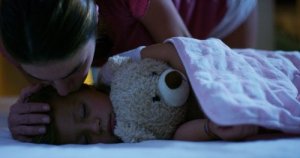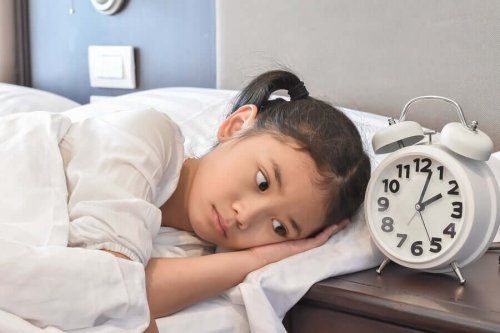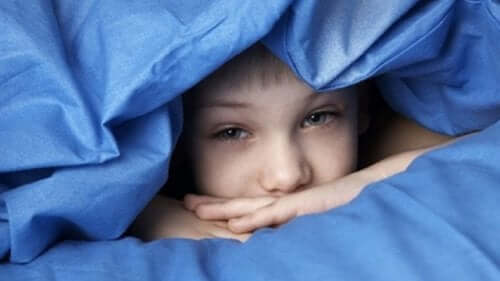The Use of Melatonin in Children to Induce Sleep


Written and verified by the doctor María Belén Del Río
Nowadays, sleep difficulties in children are a very common problem. Therefore, the use of melatonin in children to induce sleep is a very useful tool. However, you must know all about it before trying it out.
Sleep plays a fundamental role in child development, including behavior, learning, and growth. Thus, it’s something you have to monitor.
Many children suffer from sleep disorders at some point. In this regard, one of the most common is difficulty falling asleep. The causes can be varied, but it’s usually due to incorrect behavior or habits.
What is melatonin?
Melatonin is a hormone that occurs naturally in the body overnight. The pineal gland produces it from the first weeks of life and distributes it throughout the body.
Melatonin regulates the day-night and sleep-wake cycles. Thus, its blood levels are higher during the dark and less when it’s light. This is what’s called circadian rhythm.
Melatonin is hypnotic. In other words, its main function is to facilitate the onset of sleep. When it gets dark and there’s not a lot of light, melatonin acts as a messenger, alerting the body that it’s time to sleep. And the opposite happens at dawn.
Also, it acts in almost all the organs of the body. Likewise, it has other functions:
- Bone protective action.
- Regulation of gastrointestinal tract acidity.
- Control of tumor growth.
- Action on the functions of the eye.
- Immune system regulator.
- Blood pressure regulator.
- Modifies the function of certain central nervous system neurotransmitters.
The use of melatonin as a drug
Apart from the melatonin the body generates, there’s exogenous melatonin that pharmaceutical laboratories synthesize. This is what you can use in children as a medication.

There are two types of pharmaceutical presentations of melatonin:
- Quick-release melatonin. They can be tablets to swallow, tablets that you can put under the tongue, or also liquid solutions to drink.
- Extended-release melatonin. Tablets that release melatonin gradually. There are also presentations in the form of patches.
Medical professionals indicate the use of melatonin mainly in cases of altered sleep-wake cycles. For example:
- Cases of jet lag due to long trips.
- Shift workers.
- People with neurological diseases that cause sleep disorders, such as autism or mental retardation.
- Blind people who don’t produce melatonin properly due to lack of light stimulus.
The use of melatonin in children
Sometimes, medical professionals recommend the use of melatonin in children to facilitate sleep onset. Especially when their sleep-cycles are altered.
Pediatricians sometimes recommend it to children with sleep onset insomnia, which refers to children who have a hard time falling asleep. However, they must always rule out other problems and diseases beforehand, as well as adopt proper sleep hygiene.
You should never use melatonin in children without an indication from a pediatrician or sleep specialist. In fact, the Spanish Pediatric Association warns that there aren’t many clinical trials for its use in children.
Medical professionals don’t recommend the use of melatonin in children under six months. This is mainly because a baby’s sleep-wake cycle isn’t totally established when they’re five or six months old. Therefore, melatonin doesn’t demonstrate the same efficiency.
In addition, it’s necessary to control the treatment dose and duration. The amount of melatonin that medical professionals usually recommended for children is between one and three milligrams a day. In general, the treatment shouldn’t last longer than four weeks.
The patient should always take melatonin at the same time, between 30 and 60 minutes before bedtime. Also, experts state that the time the patient takes it is more important than the dose.
The use of melatonin in children should always be accompanied by sleep hygiene, environmental, and dietary measures. For example, some of these measures are:
- Creating a sleep routine.
- Following more or less fixed schedules.
- Avoiding prolonged naps during the day.
- Fostering a quiet environment.
- Maintaining an adequate room temperature (between 66 and 71 °F).
- Avoiding the use of technology an hour before bedtime.

Side effects of melatonin in children
The use of melatonin in children can cause some side effects that you need to know and monitor. For example, some of them are:
- Headache.
- Daytime sleepiness.
- Dizziness.
- Abdominal pain.
- Irritability.
- Elevated blood glucose levels.
In conclusion, the use of melatonin in children is a useful tool for inducing sleep. However, you should always use it carefully and accompany it with environmental measures. This is because it’s a synthetic hormone, a drug that isn’t without side effects.
Nowadays, sleep difficulties in children are a very common problem. Therefore, the use of melatonin in children to induce sleep is a very useful tool. However, you must know all about it before trying it out.
Sleep plays a fundamental role in child development, including behavior, learning, and growth. Thus, it’s something you have to monitor.
Many children suffer from sleep disorders at some point. In this regard, one of the most common is difficulty falling asleep. The causes can be varied, but it’s usually due to incorrect behavior or habits.
What is melatonin?
Melatonin is a hormone that occurs naturally in the body overnight. The pineal gland produces it from the first weeks of life and distributes it throughout the body.
Melatonin regulates the day-night and sleep-wake cycles. Thus, its blood levels are higher during the dark and less when it’s light. This is what’s called circadian rhythm.
Melatonin is hypnotic. In other words, its main function is to facilitate the onset of sleep. When it gets dark and there’s not a lot of light, melatonin acts as a messenger, alerting the body that it’s time to sleep. And the opposite happens at dawn.
Also, it acts in almost all the organs of the body. Likewise, it has other functions:
- Bone protective action.
- Regulation of gastrointestinal tract acidity.
- Control of tumor growth.
- Action on the functions of the eye.
- Immune system regulator.
- Blood pressure regulator.
- Modifies the function of certain central nervous system neurotransmitters.
The use of melatonin as a drug
Apart from the melatonin the body generates, there’s exogenous melatonin that pharmaceutical laboratories synthesize. This is what you can use in children as a medication.

There are two types of pharmaceutical presentations of melatonin:
- Quick-release melatonin. They can be tablets to swallow, tablets that you can put under the tongue, or also liquid solutions to drink.
- Extended-release melatonin. Tablets that release melatonin gradually. There are also presentations in the form of patches.
Medical professionals indicate the use of melatonin mainly in cases of altered sleep-wake cycles. For example:
- Cases of jet lag due to long trips.
- Shift workers.
- People with neurological diseases that cause sleep disorders, such as autism or mental retardation.
- Blind people who don’t produce melatonin properly due to lack of light stimulus.
The use of melatonin in children
Sometimes, medical professionals recommend the use of melatonin in children to facilitate sleep onset. Especially when their sleep-cycles are altered.
Pediatricians sometimes recommend it to children with sleep onset insomnia, which refers to children who have a hard time falling asleep. However, they must always rule out other problems and diseases beforehand, as well as adopt proper sleep hygiene.
You should never use melatonin in children without an indication from a pediatrician or sleep specialist. In fact, the Spanish Pediatric Association warns that there aren’t many clinical trials for its use in children.
Medical professionals don’t recommend the use of melatonin in children under six months. This is mainly because a baby’s sleep-wake cycle isn’t totally established when they’re five or six months old. Therefore, melatonin doesn’t demonstrate the same efficiency.
In addition, it’s necessary to control the treatment dose and duration. The amount of melatonin that medical professionals usually recommended for children is between one and three milligrams a day. In general, the treatment shouldn’t last longer than four weeks.
The patient should always take melatonin at the same time, between 30 and 60 minutes before bedtime. Also, experts state that the time the patient takes it is more important than the dose.
The use of melatonin in children should always be accompanied by sleep hygiene, environmental, and dietary measures. For example, some of these measures are:
- Creating a sleep routine.
- Following more or less fixed schedules.
- Avoiding prolonged naps during the day.
- Fostering a quiet environment.
- Maintaining an adequate room temperature (between 66 and 71 °F).
- Avoiding the use of technology an hour before bedtime.

Side effects of melatonin in children
The use of melatonin in children can cause some side effects that you need to know and monitor. For example, some of them are:
- Headache.
- Daytime sleepiness.
- Dizziness.
- Abdominal pain.
- Irritability.
- Elevated blood glucose levels.
In conclusion, the use of melatonin in children is a useful tool for inducing sleep. However, you should always use it carefully and accompany it with environmental measures. This is because it’s a synthetic hormone, a drug that isn’t without side effects.
All cited sources were thoroughly reviewed by our team to ensure their quality, reliability, currency, and validity. The bibliography of this article was considered reliable and of academic or scientific accuracy.
- Arboledas, G. P., Andreu, M. M., De la Calle Cabrera, T., Vicario, M. H., Hernández, P. R., Insuga, V. S., & Pérez, J. M. (2014, November). Consenso sobre el uso de melatonina en niños y adolescentes con dificultades para iniciar el sueño. In Anales de Pediatría (Vol. 81, No. 5, pp. 328-e1). Elsevier Doyma.
- Arboledas, G. P., Insuga, V. S., Luque, M. J. J., Gomariz, C. F., Vicario, I. H., Rosello, A. L., … & Madrid, J. A. (2017, March). Insomnio en niños y adolescentes. Documento de consenso. In Anales de Pediatría (Vol. 86, No. 3, pp. 165-e1). Elsevier Doyma.
This text is provided for informational purposes only and does not replace consultation with a professional. If in doubt, consult your specialist.








